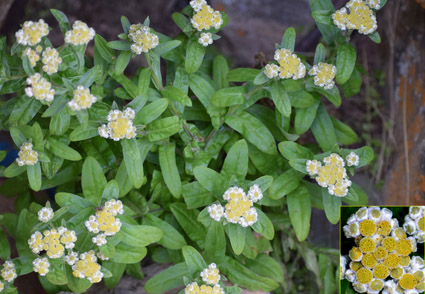Abstract
Helichrysum emodi (Gnaphalieae: Asteraceae) is described as new to science from Madhmaheshwar valley of Uttarakhand, India. Morphologically it resembles H. cutchicum and H. kashgaricum, but differs from these two species in having broad, sub-cordate to semi-amplexicaule leaf base with obtuse apex, shape of phyllaries, and absence of female florets, respectively. A detailed morphological description and illustration of H. emodi, together with pollen and habitat photographs and a key to the species of Helichrysum occurring in India are provided for the species identification.
References
- An, C.H. (1999) Flora Xinjiangensis, vol. 5. Xinjiang Science & Technology & Hygiene Publishing House, Urumqi, 506 pp.
- Beentje, H. (2000) New taxa and new combinations in Helichrysum (Compositae: Inuleae). Kew Bulletin 55 (2): 349–365. https://doi.org/10.2307/4115647
- Candolle, A.P. de (1838) Prodromus systematis naturalis regni vegetabilis, vol. 6. Treuttel & Würtz, Paris, 687 pp.
- Chen, Y., Zhu, S. & Bayer, R.J. (2011) Tribe Gnaphalieae. In: Wu, Z.Y., Raven, P.H. & Hong, D.Y. (Eds.) Flora of China, vols. 20–21. Science Press, Beijing & Missouri Botanical Garden Press, St. Louis, pp. 774–818. Available from: http://www.efloras.org/florataxon.aspx?flora_id=2&taxon_id=20582 (accessed 20 January 2024)
- Erdtman, G. (1960) The acetolysis method. A revised description. Svensk Botanisk Tidskrift 54: 561–564.
- Forman, L. & Bridson, D. (1989) The herbarium handbook. Royal Botanic Gardens Kew, London, 346 pp.
- Ghafoor, A. (2002) Anthemideae. In: Ali, S.I. & Qaiser, M. (Eds.) Flora of Pakistan, vol. 207. Department of Botany, University of Karachi, Karachi & Missouri Botanical Garden, Saint Louis, pp. 9–172. Available from: http://www.efloras.org/flora_page.aspx?flora_id=5 (accessed 20 January 2024)
- Grierson, A.J.C. & Springate, L.S. (2001) Compositae (Asteraceae). In: Grierson, A.J.C., Long, D.G. & Springate, L.S. (Eds.) Flora of Bhutan, vol. 2 (3). Royal Botanic Garden, Edinburgh, UK, pp. 1397–1632.
- Hooker, J.D. (1881) Compositae. In: Hooker, J.D. (Ed.) Flora of British India, vol. 3. L. Reeve & co., Lloyds Bank Buildings, Bank Street, Ashford, Kent, pp. 219–419.
- Jain, S.K. & Rao, R.R. (1977) A Handbook of the Field and Herbarium Methods. Today and Tomorrow’s Printers and Publishers, New Delhi, 150 pp.
- Karthikeyan, S., Sanjappa, M. & Moorthy, S. (2009) Flowering Plants of India, Dicotyledons vol. 1. (Acanthaceae – Avicenniaceae). Botanical Survey of India, Kolkata, 366 pp.
- Karthikeyan, S., Sanjappa, M., Moorthy, S., Bhattacharjee, B., Dash, S.S., Meena, S.L. & Mastakar, V.K. (2020) Asteraceae. In: Mao, A.A. & Dash, S.S. (Eds.) Flowering Plants of India—An Annotated Checklist: Dicotyledons, vol. 1. Botanical Survey of India, Kolkata, 751 pp.
- Kirpicznikov, M.E. & Kupriyanova, L.A. (1950) Morphological and palynological data for the generic taxonomy of Gnaphalieae. Trudy Botanicheskogo Instituta Akademii Nauk SSSR. Ser. 1. Flora i Sistematika Vyssikh Rastenii 9: 7–37.
- Linnaeus, C. (1753) Species plantarum. L. Salvius, Holmia (Stockholm), 1200 pp.
- Miller, P. (1754) The Gardeners Dictionary abridged. Ed. 4. John and Francis Rivington, London, 529 pp.
- Pant, P.C. (1995) Helichrysum. In: Hajra, P.K., Rao, R.R., Singh, D.K. & Uniyal, B.P. (Eds.) Flora of India, vol. 13. Botanical Survey of India, Calcutta, pp. 97–103.
- POWO (2024) Plants of the World Online. Facilitated by the Royal Botanic Gardens, Kew. Available from: http://www.plantsoftheworldonline.org/ (accessed 20 January 2024)
- QGIS Version 3.28.13 (2024) Geographic Information System. Open-Source Geospatial Foundation Project. Available from: http://qgis.osgeo.org/ (accessed 15 December 2023).
- Rao, R.S. & Deshpande, U.R. (1968) Helichrysum cutchicum (C. B. Cl.) R. Rao et Desh. – an interesting species from Western India. Bulletin of the Botanical Survey of India 10 (2): 225–227.
- Schmidt, E., Lotter, M. & McCleland, W. (2002) Trees and shrubs of Mpumalanga and Kruger national park. Jacana Media, 702 pp.
- Smissen, R.D., Bayer, R.J., Bergh, N.G., Breitwieser, I., Freire, S.E., Galbany‐Casals, M., Schmidt‐Lebuhn, A.N. & Ward, J.M. (2020) A revised subtribal classification of Gnaphalieae (Asteraceae). Taxon 69: 778–806. https://doi.org/10.1002/tax.12294
- Tzvelev, N.N. (1990) Zametki o nekotorykh slozhnotsvetnykh (Asteraceae) evropeiskoi chasti SSSR. [Notae de Asteraceis nonnullis partis europaeae URSS.]. Novosti sistematiki vysshikh rastenii 27: 145–152.


